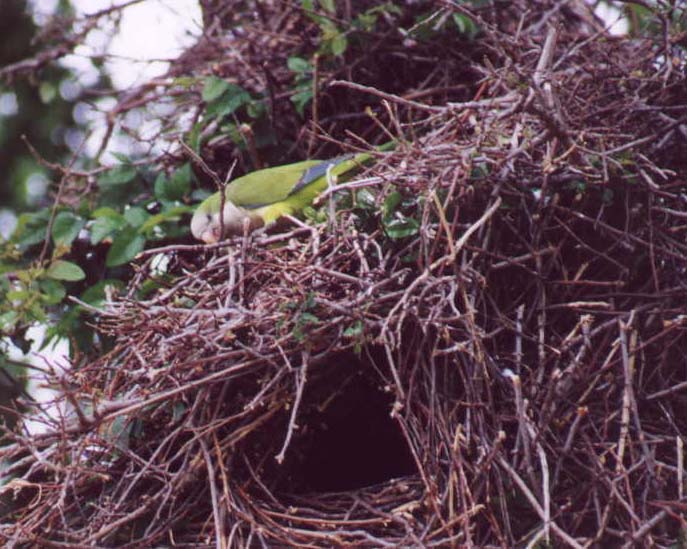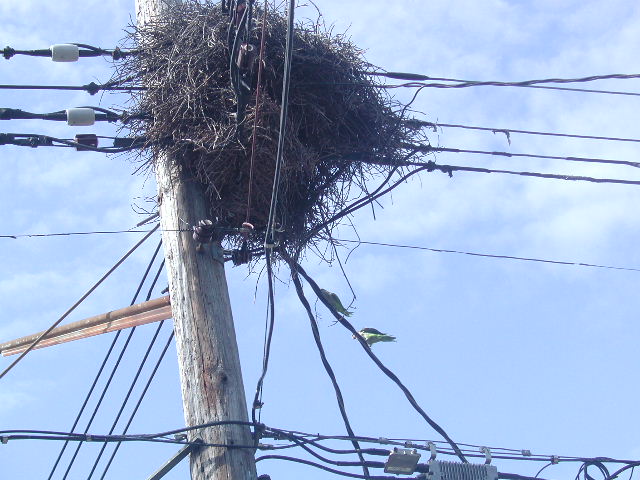DISPELLING THE MYTHSQuakers as an agricultural threat-
In the Quaker's South American countries of origin, Quakers are considered to be agricultural pests. As a wild, naturalized species in the US, Quakers seem to prefer urban settings and have not proven to be a threat to agriculture.
Quakers as displacers-
In Connecticut, Quakers have shared nesting area with native species, such as the Great Horn Owl. Wild Quakers flocks have been spotted sharing feeding space, (i.e. at residential bird feeders), with a variety of native species.
� QPS 2025-4-5-6 All Rights Reserved
No reuse or reproduction of photographic materials on this page without express written permission of the contributing owner
|
FREEDOM?Is the Quaker which you have chosen for companionship and shares its home with you the same Quaker who lives in a wild setting? Absolutely not. Though our domesticated Quakers may retain remnants of instinctual behavior, years of careful breeding, perfected diet, and purposeful socializing to make a Quaker acceptable as a human companion, leaves Quakers born in captivity ill prepared to face the dangers and hardship of living in the wild.
Some people are not prepared before ownership for behaviors which a Quaker, especially as it matures, might exhibit. They may not have realistically weighed the time, money, and effort a companion Quaker requires on the part of the owner and human companion. They might not know, or have access to resources which would equip them to better their relationship with their companion Quaker. Some people may begin to feel guilty that their bird's home is a "cage", and that it is not "free-flying"; believing it exhibits unwanted behaviors because it hears "the call of the wild."
The fact is it is cruel to release a companion Quaker into the wild. At best, the released bird that is unprepared for foraging for its own food faces the possibility of death by starvation, attacks by other animals, such as dogs, cats, predatory wild birds, and even by the wild Quakers they might encounter, who are not readily accepting of those outside their established flocks. The life of a wild Quaker, who is part of an established flock or colony, may appear romantic, but it is simply not. Because the wild Quaker faces very real dangers each and every day, receives no medical attention, and is forced to sustain itself as best it can, its life expectancy is considerably less than that of the companion Quaker.
|
ALTERNATIVESWild Quaker colonies in urban settings will chose nesting areas that afford warmth, protection from, and a view of predators, in a close proximity to a reliable and preferred food source. In urban settings, this means a Quaker colony might chose to erect their nest on utility equipment, much like Ospreys have in like settings.
Because the Osprey is a native species in the US, conservationist agencies and individuals have made considerable effort to provide alternative nesting for Osprey, either directly on utility equipment, or in close proximity.
As a "naturalized species", Quakers are not currently entitled to the same protection as a "native species", but, individuals, avian organizations, and some power companies are looking toward the idea of alternative nesting, as well as other possible solutions, which would allow wild Quaker colonies to exist harmoniously with human beings and other native avian species in urban settings.
QPSERC (Education &Research) is eager to hear your ideas and opinions about the nesting preferences of wild Quakers, along with any ideas you might have about alternative nesting, or ways to successfully deter nesting on power equipment which will still allow wild colonies to exist harmoniously in urban settings. Please write to:
QPSERC
|









